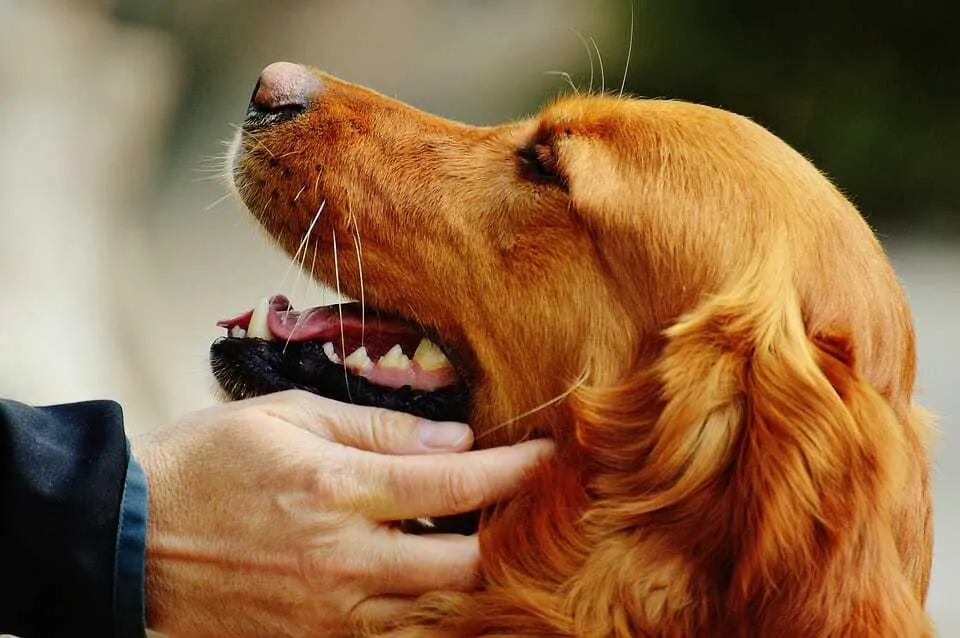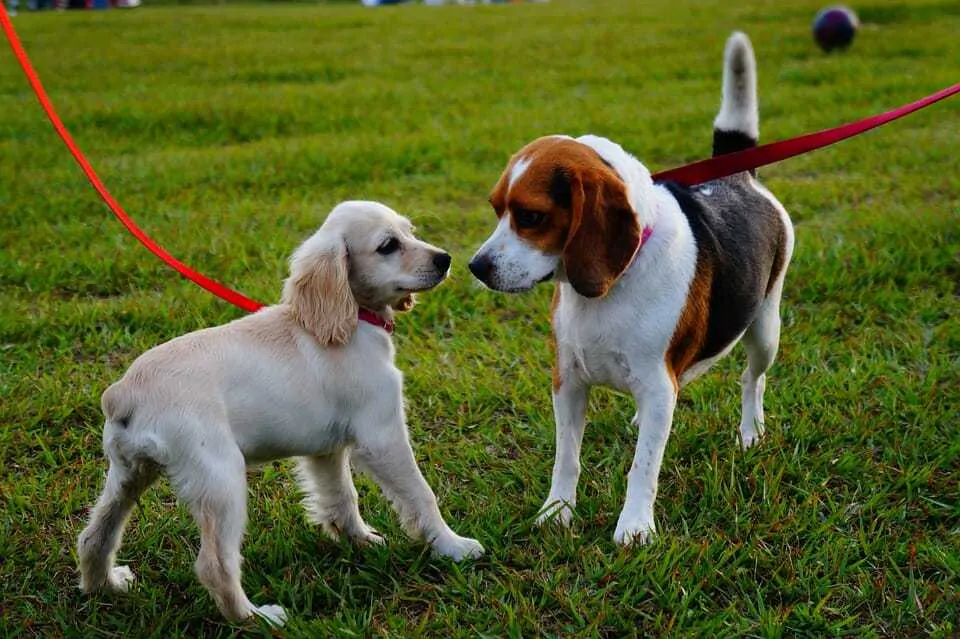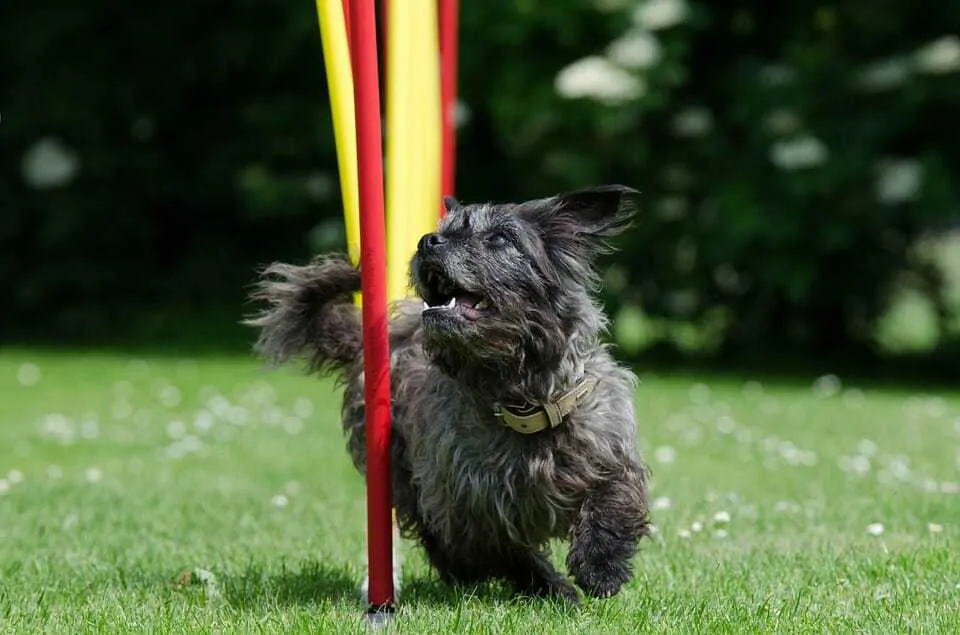My Cocker Spaniel, Daisy, had chronic ear problems when she was still a relatively young dog. Whilst we were eventually able to get this under control it left her with slight deafness. As she got older her hearing lessened until by the time she was around ten or eleven she had complete hearing loss.
Whilst we did have to make a number of changes to the way we worked things, her deafness didn’t cause any major issues for us and it certainly did not impact on Daisy’s quality of life. We were also lucky as many of the commands we already used with Daisy were ones that had verbal commands that were accompanied by visual cues so it made things a bit easier when it came to training.
So, if you have a dog that was born deaf or has developed deafness in later life, don’t despair. With a slightly different approach to training and lifestyle, your dog will live a full and happy life.
Daisy didn’t let being deaf hold her back. She was a happy and healthy dog and a pleasure to be with
Contents
1. Dogs can be deaf for a variety of reasons
Some dogs are born deaf, they may have had a congenital condition. Some dogs develop deafness due to an illness or accident and, most commonly, dogs develop deafness as they move into older age, just like people can.
Certain breeds are more likely to have pups that are born deaf. The most commonly affected is the Dalmatian but there are more than 50 other breeds that have been proven to have a propensity to deafness including Boston Terriers, Cocker Spaniels and German Shepherds. Dogs that have a lot of white pigmentation are known to be more susceptible to deafness too.
If they are deaf from birth, they don’t know any different and your approach to training will be to start as you mean to go on.
For dogs that go gradually deaf, you may have time work on changing your approach over a period of time.
For dogs that suddenly become deaf, you may need to be more patient with your dog whilst they adjust to this sudden change but, with patience and kind training, they can go on to learn a new signing vocabulary and you will likely be surprised by their resilience.
Dalmatians are the breed most commonly associated with congenital deafness, it doesn’t stop them being a wonderful, clever and energetic breed
2. How do I know my dog is deaf?
If you have a dog that has had hearing and then becomes deaf it will likely be more obvious to you that there is an issue. When once they responded to vocal commands they may be appearing to ignore you. They may not respond to things they used to, maybe they previously alert barked when the doorbell rang or perhaps they were scared of loud bangs and they no longer seem to react.
For dogs that are born deaf, it can sometimes take longer to establish that your dog cannot hear you. They may be more rough with their littermates (they are not hearing the warning squeals if they are being too full on), they will not respond to squeaky toys, they may not rouse from sleep as quickly as you would expect
3. Check in with your Vet
We would always recommend visiting your Vet if you suspect hearing problems. Not only will they perform tests to establish if there is an issue but they can also check if it may be treatable. Sometimes there could be a foreign object impeding hearing or an infection or other illness that could be treated to restore hearing.
4. Avoid startling your deaf dog
Deaf dogs are more likely to get a fright if approached unexpectedly. Unlike hearing dogs, if they are sleeping they will not be so likely to wake up as you approach them. You can’t shout their name to wake them up.
If they do get startled and get a real fright they may be more likely to snap as a fearful knee-jerk reaction.
It is really important to approach a deaf dog with more consideration. Always ask your visitors not to approach a deaf dog whilst sleeping.
If you are waking them, do this gently. We would recommend holding a treat out for them. The smell is likely to rouse them and then they are waking to something positive rather than in fright.
When they are awake, always approach them when you are in their field of vision. Coming up behind them suddenly can be frightening.
A deaf dog can startle more easily, always make sure you approach with consideration, especially when they are sleeping
5. Getting their attention
If your dog is not facing you, some people will stamp their feet and this is often enough for your dog to feel the vibration and turn towards you. Some people use a laser light or flashlight. If you are using a flashlight don’t shine it directly in your dog’s eyes! We are not fans of the laser light as some dogs can become unhealthily fixated on this.
Sometimes, if your dog is at a distance from you, you may have to accept that you won’t be able to get their attention as easily. Sometimes switching lights on and off can work or you may just go have to fetch them away (remembering to approach without startling them).
6. As with any dog, positive training techniques and consistency equal a winning formula
As we recommend for any training, always use reward based, force-free training techniques. Scientifically proven and kind, this will be an effective, consistent method that will ensure you develop a strong bond of trust with your dog.
7. Make sure they are comfortable being touched
Because physical contact can be a useful way of getting your dogs attention it is important to make sure that your dog is comfortable with this.
Often people use a specific touch to get their dogs attention in advance of giving them another command. If you are doing this, it should be a gentle touch in the same place. The touch should be accompanied by giving them a super tasty treat and this should be repeated regularly and in different in environments. This will ensure they are comfortable with the contact and will also ensure that they are more willing to give you their focus.
Ensure that your dog is comfortable being touched. Always associate contact with positive things: treats, praise, affection
8. Visual markers are key
Some people choose to use official sign language signs, others use their own signs. As long as they are clear and consistent it is really up to you.
When training a new sign, get your dogs attention and then when they offer the behaviour you are looking for when you use the sign for it make sure you offer a tasty treat and then repeat.
Food rewards can be gradually reduced and replaced with different types of praise (affection, toys, whatever your dog finds rewarding that you are happy to offer).
9. Can I let my deaf dog off leash?
Unless your dog is in a safe, enclosed area we would not recommend having a deaf dog off leash. It is more difficult to get a reliable recall from a deaf dog and often it is not worth the risk.
If you can offer your dog the opportunity to have off lead time in a safe and enclosed space this is great. If not, make sure they can have plenty of loose lead time and opportunities to sniff. Some people use a long line to give them the opportunity for more freedom. Always make sure your dog wears a harness if using a long line to avoid any sudden extreme pressure on their neck.
Some people do choose to have a deaf dog off lead but it does require a lot of time and patience. You need to work on getting a reliable check-in from them so that they can then see if you are asking them to return.
If you do decide to work on it you would follow similar steps to those described in our recall training article using a visual cue but you would make sure that you look for very regular check-ins as part of the training sessions.
10. Enrich their life with scenting opportunities
Dogs love to smell! Their scenting abilities are thousands of times stronger than humans. Perhaps you will want to consider a Snuffle Mat to let them scent out food and treats in a controlled environment.
We always recommend giving your dog the opportunity to sniff when out on walks. Because deaf dogs should generally not be off leash whilst out on a walk, it is even more important to give them the time to have loose lead sniffing opportunities.
11. Be extra vigilant when introducing new dogs
Because deaf dogs will not hear any verbal communication from other dogs it is important to be even more vigilant when introducing a new dog to a deaf dog.
Whilst dogs are good at reading body language, they will not hear any barks or growls or other vocalisations and sometimes that can cause miscommunication.
Make sure introductions with new dogs are carefully supervised. Deaf dogs will not react to any vocalisations and this can sometimes confuse the other dog
12. Extra products that can be useful for deaf dogs
There are certain products that can be useful to consider if you have a deaf dog. These include:
a) Deaf collar/harness/leash
You may wish to consider getting these products with the words “Deaf” on them. This means that people will hopefully be more understanding if your dog doesn’t respond if someone tries to speak to them. People will be less likely to startle your dog by approaching them suddenly from our of their eye line.
b) Bells
Some people choose to pop a bell on their dog’s collar so that they know where their dog is in the house or yard. The Bear Bells we are recommending are very robust and make a good clear noise, they may be a bit bulky for the smaller breeds though.
c) Vibrating collar
Some deaf dog owners use a remote control vibrating collar to help get their dogs attention. It is often used for helping with recall. This is one that needs to be considered with caution. Some dogs can be frightened of the vibration so it needs to be introduced very carefully and in conjunction with tasty treats so it is associated with something positive.
If your dog is frightened of it don’t use!
NEVER consider using a shock or spray collar to get their attention. We never advocate the use of these products as they can be painful and frightening for your dog and can often cause more problems than they would solve.
13. Some of the positives of owning a deaf dog
If your dog was previously sound sensitive or reactive, this will no longer be a problem.
Dogs that were afraid of fireworks, thunder, loud construction works etc may no longer experience this anxiety. You may have had a dog that barked incessantly at the doorbell and the no longer do this.
Once our Daisy was deaf she accompanied us unperturbed to a firework display, we could never have done this before. Do be aware though that this may not be suitable for all dogs, some dogs may still be anxious if they feel bang vibrations or see the large bright lights of fireworks.
Your bond with your dog will likely grow with the increased training that you have to do.
14. Don’t let your dog’s deafness limit what they can do
Don’t forget that dog’s don’t carry the same kind of hang-ups that humans do. Your dog does not care that they are deaf and you shouldn’t let it limit what they do.
Deaf dogs can still take part in the activities that hearing dogs do, you may just have to use different strategies to support them. There are plenty of deaf dogs that take part in Agility, Cani-Cross, competition Obedience etc. Lots of deaf dogs are therapy dogs too.
Don’t let your dog’s deafness limit their potential. May deaf dogs still take part in doggy sports like agility
15. Some Deaf Dog Myths
a) MYTH: They are harder to train
Deaf dogs are not less intelligent than any other dog. You may have to adopt slightly different training strategies but, providing you are clear and consistent, your dog will pick this up just as quickly as they would otherwise.
b) MYTH: They are more likely to be aggressive
This is not true. Granted, it can be easier to startle a deaf dog but then it is all about ensuring that you approach them appropriately.

Jen Jones is a professional dog trainer and behavior specialist with more than 25 years of experience. As the founder of ‘Your Dog Advisor’ and the ‘Canine Connection’ rehabilitation center, she applies a holistic, empathetic approach, aiming to address root causes rather than merely treating symptoms.
Well known for her intuitive and compassionate approach, Jen adopts scientifically-proven, reward-based methods, encouraging positive reinforcement over punishment. Jen specializes in obedience training, behavior modification, and puppy socialization. Her innovative methods, particularly in addressing anxiety and aggression issues, have been widely recognized. Jen has worked with many of the world’s leading dog behaviorists and in her free time volunteers with local animal shelters and rescue groups.





